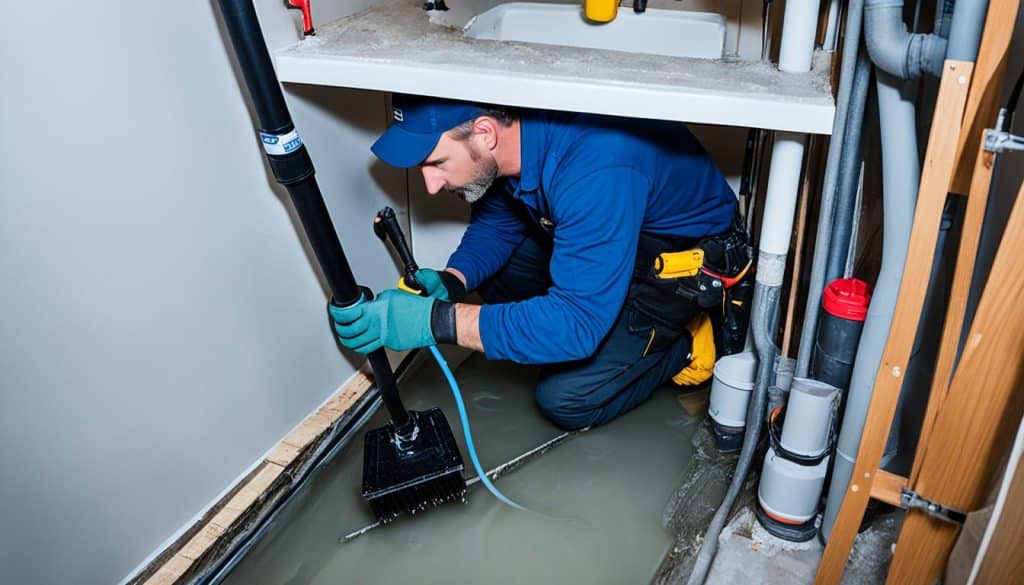Ever wondered Where Should a Sump Pump be Installed in my Basement? Getting the sump pump in the right spot is key for keeping your basement dry. This is especially true in places like the Midwest, where the weather can be extreme. The best spot is usually the basement’s lowest point, where water can be collected and pushed out efficiently.
Installing a sump pump can be tricky, sometimes needing a jackhammer to dig a pit. That’s why many homeowners turn to the pros. Companies like J Sewer & Drain Plumbing Inc. are known for their reliable service and strong guarantees, making them a top pick.
Key Takeaways
- Strategic sump pump placement is critical for effective basement waterproofing.
- Install the sump pump at the basement’s lowest point for optimal efficiency.
- Professional installation may be necessary due to the technical and physical demands.
- Reliable companies like J Sewer & Drain Plumbing Inc. offer guarantees on their work.
- Properly installed sump pumps protect against severe weather-related water intrusion.
The Importance of a Sump Pump in Basement Water Management
A sump pump is crucial for a dry and safe basement. It’s key to keeping water out. This helps protect your home’s foundation from water damage.
Why Every Basement Needs a Sump Pump
If your basement gets wet or floods, you need a sump pump. It’s vital for homes with finished basements or valuable items. A sump pump stops flooding and saves your home from water damage.
Signs You Need a Sump Pump
Look out for puddles, standing water, or too much moisture. These are signs you need a sump pump. Homes in wet areas or at risk of flooding should get one. Experts say a battery backup is a must to keep it working when the power goes out.

Choosing the Right Location for Your Sump Pump
Finding the perfect spot for your sump pump is key for it to work well. Let’s look at what matters most for a good installation.
Identifying the Lowest Point
The best place for your sump pump is usually the lowest spot in your basement or crawl space. Water naturally flows to the lowest point. So, it’s smart to put your sump pump there.
Putting it near a foundation wall and in a corner where drain pipes run can make it work better.
Accessibility and Convenience
While the lowest point is important, being easy to reach for upkeep is also key. Make sure your sump pump is in a spot you can easily get to for checks and maintenance. It should also be near an electrical outlet and have a clear path for the discharge pipe.
Getting help from experts like J Sewer & Drain Plumbing Inc. can guide Chicago homeowners to find and set up the best spot for their sump pumps.
Installing a Sump Pump: What to Consider
When you plan to install a sump pump, you need to think about a few important things. These include making sure it’s safe and works well. You should pay close attention to electrical access and how you dig the area.

Proximity to Electrical Outlets
One key thing to remember is to place the pump near an electrical outlet. The sump pump needs its own power source and can’t use an extension cord. This is because it’s not safe.
If there’s no outlet nearby, you might need to get an electrician to add one. Having the right electrical setup is crucial for the pump to work right.
Excavation and Placement
Another important step is digging the sump pump basin. This can be tricky, especially if your basement has a thick cement floor. You might need a pro to do this right and safely.
Experts like those at J Sewer & Drain Plumbing Inc. in Chicago can help. They have the skills and tools to make sure the job is done well.
Maintaining Your Sump Pump for Optimal Performance
Keeping your sump pump working well is key for a dry basement. You should test and check it regularly. The best times for this are early spring and fall when it’s not too wet.
Routine Testing and Inspections
Homeowners should test their sump pump at least twice a year. A simple test is to pour water into the pit to see if the pump works. It’s also smart to get a professional to check it for any mechanical problems.
Regular upkeep helps avoid expensive fixes and keeps your basement dry. It’s a crucial part of keeping your basement safe from water.
Backup Systems
Having a battery backup for your sump pump is a good idea. It keeps your pump running even when the power goes out. This is very important in areas that get a lot of storms.
For help with your sump pump, you can count on J Sewer & Drain Plumbing Inc. They offer great service and have special deals for their customers in Chicago, IL. They make sure your sump pump stays in top shape without breaking the bank.
Conclusion
Installing and maintaining a sump pump is key to stopping basement flooding. It keeps your home safe from water damage. Choose the right spot, like the basement’s lowest point, for the best results.
Regular checks and a backup system are also vital. They make sure your sump pump works well. And they give you peace of mind when power goes out or the pump breaks.
If you want experts to handle it, J Sewer & Drain Plumbing Inc. is a great choice. They serve Chicago and nearby areas with top-notch service. By following these tips and getting help when needed, you can keep your basement dry and your home safe.


